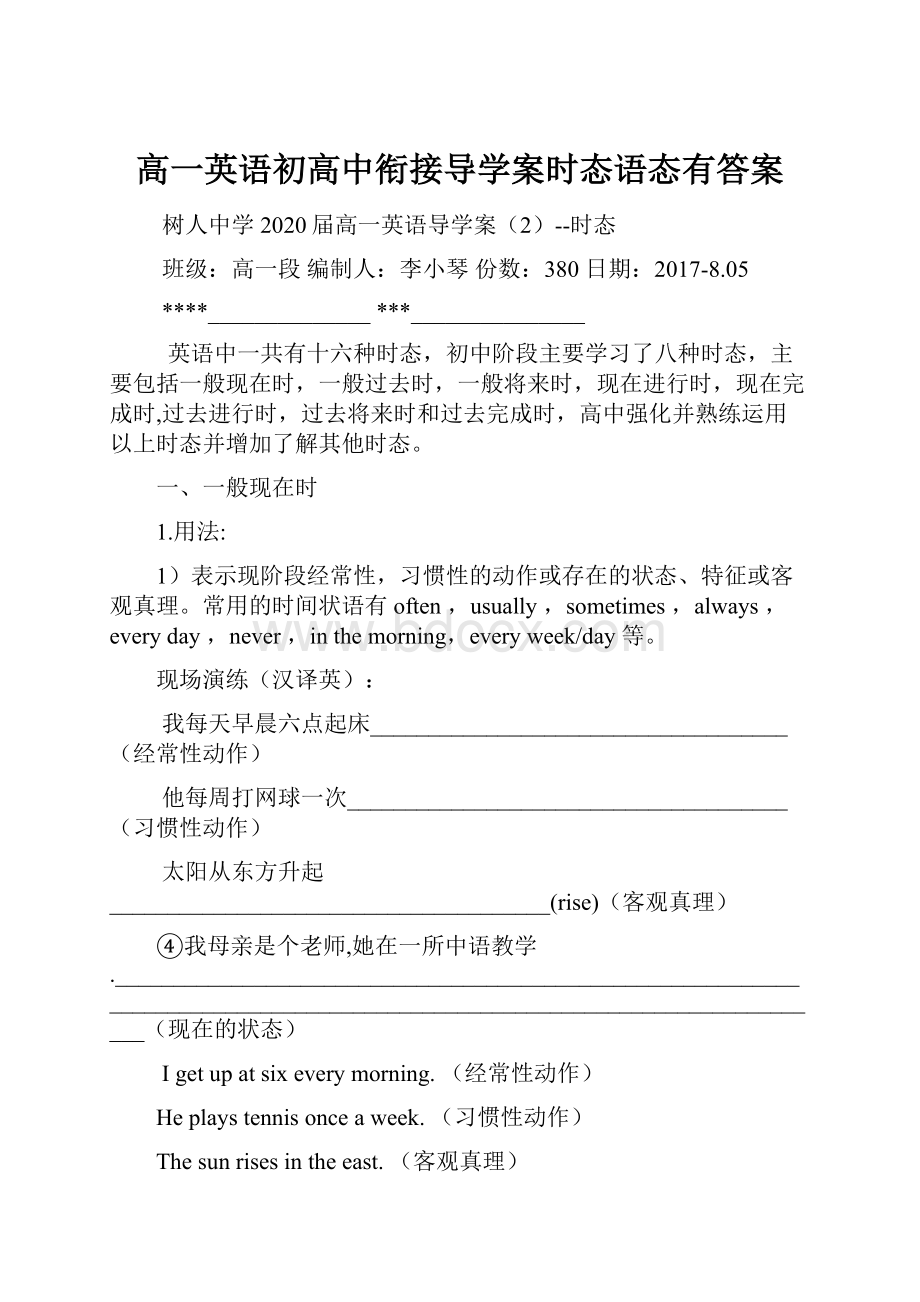 高一英语初高中衔接导学案时态语态有答案文档格式.docx
高一英语初高中衔接导学案时态语态有答案文档格式.docx
- 文档编号:22102959
- 上传时间:2023-02-02
- 格式:DOCX
- 页数:15
- 大小:25.20KB
高一英语初高中衔接导学案时态语态有答案文档格式.docx
《高一英语初高中衔接导学案时态语态有答案文档格式.docx》由会员分享,可在线阅读,更多相关《高一英语初高中衔接导学案时态语态有答案文档格式.docx(15页珍藏版)》请在冰豆网上搜索。

动词的单数形式变化规律:
1.大多数动词在词尾加―S在清辅音后发音为[s],在浊辅音及元音后发音为[z]。
如:
2、以辅音字母加y结尾的,要先将y变为i,然后在加―es‖读[iz]3、以s,x,ch,sh结尾的,在词尾加―es,发音为[iz]如:
4、以―o结尾的动词,加es,读[z]如:
2.构成规律:
1)主语是I,we,you,they和名词复数时作谓语的行为动词用原形。
主语是he,she,it和名词单数时,动词使用第三人称单数。
2)主语为第三人称和名词单数时:
肯定式:
S+V/动词的第三人称单数/S+be+P.
否定式:
S+don'
t/doesn'
t+V+其他/S+be+not/+P
一般疑问式:
Do/Does+S+V+其他?
/Be+S+P?
简略回答:
(肯)Yes,S+do/does./Yes,S+be.
(否)No,S+do/doesnot./No,S+benot.
特殊疑问式:
特殊疑问词wh-/how+一般疑问式?
拓展尝试:
请把以上例句-④根据构成规律写出它们的否定句,疑问句
中考真题:
1.C——Canyourfatherdrive?
(08武汉)——Yes,andheusuallytoschool.
AdroveBisdrivingCdrivesDhasdriven
2.CIfIfindhisphonenumber,Iyou.(09北京)
AtellBtoldCwilltellDhavetold
3.ATheteachertoldthestudentsthattheearthround,notflat.(08天津)
AisBwasChasbeenDisbeing
高中真题初探:
2016全国高考语法填空
YangShuo(阳朔)_____is_(be)reallybeautiful.Thiscyclegoes(go)dayafterday.
拓展提问:
你知道一般现在时态的被动语态结构吗:
_____________________
拓展练习2014辽宁:
TaiChi(太极)iscalled_________(call)“shadowboxing”.
二、一般过去时
1.表示过去某段时间发生的事,存在的状态或过去反复发生的动作时用一般过去时。
常用的时间状语:
then,afterthat,yesterday,threemonthsago,lastyear,in1979等。
2.用法:
1)过去发生的动作。
现场演练Thepolicestopped(stop)meonmywayhomelastnight.
2)过去存在的状态。
现场演练.Theywerenot_________(benot)abletocomebecausetheyweresobusy.
3)两个紧接着的动作,有以下单词but,and,when,assoonas,themoment,连接,常用于故事或短文中。
现场演练:
ItwasrainingwhenI_arrived_(arrive)inYangShuo..
3.构成:
S+V-ed
1)用动词的过去式。
作谓语的行为动词的词尾变化如下:
一般情况
+ed
以e字母结尾的辅音
+d
以辅音字母+y结尾
去y变i+ed
重读闭音节结尾的单词,末尾只有一个辅音字母
双写词尾字母+ed
注意:
不规则的动词的过去式和过去分词是我们必须背诵和掌握的重点。
2)一般过去时态的肯定句、否定句和疑问句形式(以be和like为例):
主语
肯定式
否定式
(一般)疑问句
第一、二人称和第三人称复数以及名词复数
Iwasastudent.
We/You/Theywerestudents.
He/Shewasastudent.
I/We/You/They/likedmusic.
Manypeoplelikedmusic.
Iwasnotastudent.
We/You/Theywerenotstudents.
He/Shewasnotastudent.
I/We/You/They/didn’tlikemusic.
Manypeopledidn’tlikemusic.
Wereyouastudent.
Wereyou/theystudents?
Washe/sheastudent?
Didyou/theylikemusic?
Didmanypeoplelikemusic?
1.WewereinQingdaolastweekandgreatfunthere.(08北京)
AwillhaveBhavehadChadDhave
高考习题初探:
1,写作改错:
IwaswenttoFred’shouseandaskshimtogotoschoolwithme.Buthedon’ttookmyadviceandseemednothappy.
IwenttoFred’shouseandaskedhimtogotoschoolwithme.Buthedidn’ttakemyadviceanddidn’tseemhappy.
2,广东2015Whilemakingeffortstorunaway,he__fell____(fall)overanddied.
3,*2014广东We__weretold_______(tell)thatourroomshadn’tbeenbookedforthatweek.
三、一般将来时(will/shall/begoingtodo)
1.用法:
表示将来某个时间要发生的动作或存在的状态,常用于一般将来时的时间状语:
tomorrow,nextweek,in2020,inthecoming/followingweeks,soon,in100years等。
1)将要发生的动作。
现场演练I_willset/shallset/_______________(set)offforBeijingtomorrow.
2)将要存在的状态。
现场演练.Thistimenextyearhe_willbe______(be)inJapan.
3)打算要做的事。
现场演练Areyou__goingtowatch________(watch)thefilmontelevisiontonight?
4)come,go,start,move,sail等动词常用现在进行时态表示按计划将要发生的事。
Thewholefamilyisgoingfortwomonths.
5)在条件状语从句和时间状语从句中,主句用一般将来时,从句用一般现在时表示将来。
现场演练.Ifyou_don’tgo_(notgo)soon,youwillbe_(be)late.
2will和begoingto的区别:
1)表示带意愿色彩的将来用will。
e.g.Iwillstaywithyouinthefuture.
2)询问对方是否愿意或表示客气的邀请和命令时用willWillyougotothepark?
3)表示客观的将来,用will.Iwillbe22yearsoldnextyear.
4)begoingto常用于口语中用来表示即将发生的动作或存在的状态。
e.g.We’regoingtohelpsomefarmerswiththeirwork.
5)表示打算或准备要做的事用begoingto.She’sgoingtoleaveat10o’clocktomorrow.
6)根据某种迹象判断可能要发生的事用begoingto。
It’sgoingtorain.
1.B——Whyareyouinsuchahurry,Mike?
(11福州)
——ThereanNBAbasketballgameintenminutes.
AwillhaveBwillbeCisgoingtohaveDaregoingtobe
2.AInfiveyears,Iadoctor.(08)AwillbeBwasCam
3.CIftheycome,ameeting_______.AhaveBwillhaveCwillbeheldDwouldhave
高中习题初探:
请选用以下若干词汇组成一般将来时的句子
(Sylvie,hergrandmother,theyoungman,10dollars,pinetree,give)
__________________________________________________________________________________________________________________________________________
四、现在进行时
1.用法:
1)说话时正在进行或发生的动作(动作是在说话时正在进行)。
常用于现在进行时态的时间状语:
now,look,listen,rightnow,thesedays,等。
现场演练.She_ishaving________(have)abathnow.
2)现阶段正在进行或发生的动作(但是动作并不是必须在说话时正在进行)。
现场演练You_areworking_________(work)hardthesedays.
3)频度副词always,forever等词连用时,表示某种强烈的感情。
.Heisalwaystryingoutnewideas.
4)表示按计划即将发生的动作(仅限于go,come,arrive,leave,start,fly,begin,stay等动词)。
e.g.Thepartyisbeginningat8:
00o’clock..
5)“系动词+介词/副词”表示正在进行的动作。
.Heisatwork.
6)表示感觉、愿望和状态的某些动词如hope,smell,hear,see等一般不用进行时态。
2.构成:
be+v-ing
1)v-ing现在分词的构成:
cook-cooking
以不发音字母e结尾的单词。
去e,加ing
make-making,taste-tasting
以重读闭音节结尾的单词,末尾只有一个辅音字母时.
run-running,stop-stopping,
2)肯定句、否定句、疑问句形式:
肯定句:
S+be+V-ing否定句:
S+be+not+V-ing
一般疑问句:
Is(Are)+S+V-ing?
Yes,S+be/No,S+benot
特殊疑问:
wh_+be+S+V-ing?
疑问式
Iamdriving.
He/She/Itisworking.
We/You/Theyaredoingsomething.
Iamnotdriving.
He/She/Itisnotworking.
We/You/Theyare__not___doinganything.
Are_you_driving____?
Ishe/she/itworking?
Areyou/theydoingsomething?
1.BMr.Greentothemanagernow.You’dbettercallhimlater.(09北京)
AtalkBistalkingCtalkedDwastalking
2.AEverythingontheearthallthetime.
AischangingBischangedChaschangedDhasbeenchanged
3.CBequiet,please.Thestudentsaclassnow.(08长春)
AhaveBhadCarehavingDwerehaving
填空并判断下列句子是否是现在进行时(F、T)
(F)1.Keepholding(hold)yourplaceforawhile.(F)2Themovieis__interesting______(interest)3,(T被动语态)Thetigerisbeingkilledeveryday.
五、过去进行时
过去某一阶段或某一时刻正在进行的动作。
常用于过去进行时的时间状语有atfouryesterdayafternoon,then,atthattime/moment等。
现场演练ThistimelastyearI__wasliving_______(live)inBrazil.
What____were____you___doing____(do)at10o'
clocklastnight?
2.构成:
was/were+v-ing
3.一般过去时和过去进行时的区别:
1)一般过去时:
强调过去某个时候曾有过某个动作(已经完成的)。
2)过去进行时:
强调动作在过去的某个时候或某个时间段内正在进行(是否完成不明确)。
现场演练:
.Marywrotealettertoherfriendlastnight.(动作是/否完成)
Marywaswritingalettertoherfriendlastnight.(动作是否完成)
1.C——Wereyouathomeat7o’clocklastnight?
(09宁波)
——Yes,Iashoweratthattime.
AtookBamtakingCwastakingDwastaken
2.BImyhomeworkwhilemyparents_________TVlastnight.(06南京)
Adid;
havewatchedBwasdoing;
werewatching
Chaddone;
werewalkingDwoulddo;
werewatching
高考习题初探:
I___________(make)asockwhenavoicecalledme.
六、现在完成时
1)表示过去发生或已经完成的动作对现在造成的影响或结果,常与already,just,ever,never,before等副词连用。
现场演练.Shehasnever_read_thisnovel.
2)表示“过去的动作”一直延续到现在并有可能继续延续下去。
常与for(后跟段时间)或since(后跟点时间)等连用。
现场演练.I_havebeen__(be)amemberofthePartyfor10years./since10yearsago.
3)在有for和since引导时间状语的句子中不能用短暂性动词(die,arrive,close,become,come,fall,leave,go,lose,give,jump),应用与之相应的表示状态的词。
现场演练正(T)误(F)判断(F)Hehasdiedfor3years.
(T)Hehasbeendeadfor3years.
4)当表示动作、状态持续时用延续性动词(work,stand,know,walk,keep,have,wait,watch,read,sleep)。
延续性动词一般不与表示“点”的时间状语连用。
()Itrainedateightyesterdaymorning.
(√)Itbegantorainateightyesterdaymorning.
1)have/has+v-ing
2)现在完成时态的肯定句、否定句和疑问句形式(以be和see为例):
肯定句:
S+have(has)+V-ed
否定句:
S+have(has)+not(haven’t,hasn’t)+V-ed
一般疑问句:
Have(Has)+S+V-ed+?
特殊疑问句:
wh_+have(has)+S+V-ed+?
I/We/You/Theyhavebeenherebefore.
He/Shehasbeenherebefore.
.I/We/You/They/Manypeoplehaveseenthefilm.
I/We/You/Theyhaven’tbeenherebefore.
He/She_hasn’tbeenherebefore.
.I/We/You/They/Manypeoplehaven’tseenthefilm.
Haveyou/theybeenherebefore?
Hashe/shebeenherebefore?
Haveyou/they/manypeopleseenthefilm?
3.现在完成时与一般过去时的区别
1)侧重点不同。
现在完成时强调过去的动作对现在造成的影响;
一般过去时只是一种过去的时态,与现在无关。
YesterdayIwenttothezoo.(动物园对我是/否有影响)
LiLeihasreadthebook.(这本书对我是/否有影响)
2)标记的时间状语不同。
现在过去时:
already,yet,still,just,sofar,before,ever,never,since+一段时间,for+一段时间。
一般过去时:
ago,yesterday,lastyear,in2000,justnow.
Haveyouever__picked______(pick)flowersorsteppedonthegrassinapark?
Father_bought_________(buy)thatwatchtenyearsago.
4havebeento,havegoneto,havebeenin的区别
1)havebeento表示过去曾去过某地,现在已经不在该地了。
常与just,ever,never等连用,后面可接次数,表示去过某地几次。
2)havegoneto表示到某地去了,说话时该人不在说话地点,或者已到该地,或在途中。
一般主语不用第一、第二人称。
3)havebeenin表示已经在某地待了多久。
常跟for+一段时间,表示在某地待了多长时间。
1
- 配套讲稿:
如PPT文件的首页显示word图标,表示该PPT已包含配套word讲稿。双击word图标可打开word文档。
- 特殊限制:
部分文档作品中含有的国旗、国徽等图片,仅作为作品整体效果示例展示,禁止商用。设计者仅对作品中独创性部分享有著作权。
- 关 键 词:
- 英语 高中 衔接 导学案 时态 语态 答案
 冰豆网所有资源均是用户自行上传分享,仅供网友学习交流,未经上传用户书面授权,请勿作他用。
冰豆网所有资源均是用户自行上传分享,仅供网友学习交流,未经上传用户书面授权,请勿作他用。


 1212中级汽车维修工考试试题三.docx
1212中级汽车维修工考试试题三.docx
